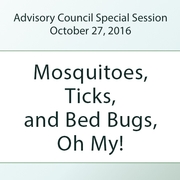Special Session: Mosquitoes, Ticks, and Bed Bugs, Oh My!
Three scientists presented on the topic of insects that often feed on humans—mosquitoes, ticks, and bed bugs—during a special session at the annual meeting of the Advisory Council of the Northeastern IPM Center in Baltimore, Maryland on October 27.
The presentation slides for all three talks are available below. Regrettably, we were only able to capture a recording of the first session due to technical problems with the webinar software, but we invite everyone to explore these important pest topics here and throughout our website. If you have questions or comments specific to any of these presentations, we would encourage you to contact the speakers.
Mosquitoes: Dr. Paul Leisnham
Dr. Paul Leisnham, University of Maryland
Email: leisnham@umd.edu
Website: https://www.enst.umd.edu/people/faculty/paul-leisnham
Should we be concerned about Zika, Chikungunya or other emerging mosquito-borne diseases in the northeastern United States? Paul Leisnham of the University of Maryland addressed this question by considering important social and ecological dimensions of mosquitoes in urban landscapes. He specifically focused on recent interdisciplinary and collaborative research from Washington, D.C. and Baltimore.
Ticks: Dr. Kirby Stafford
NOTE: Due to technical problems, we were unable to capture a recording of Kirby Stafford’s presentation.
Dr. Kirby Stafford, The Connecticut Agricultural Experiment Station
Email: Kirby.Stafford@ct.gov
Website: http://www.ct.gov/caes/cwp/view.asp?a=2812&q=345076
Kirby Stafford of the Connecticut Agricultural Experiment Station discussed tick-borne diseases, including Lyme and others. Lyme disease is the leading arthropod associated disease in the United States with an estimated 300,000 people diagnosed with Lyme each year. However, the blacklegged tick (aka, deer tick), Ixodes scapularis, is the vector for at least five other human pathogens that cause babesiosis, anaplasmosis, a recently recognized relapsing fever Borrelia, and Powassan encephalitis, and a newly described Lyme Borrelia. Stafford highlighted the various tick-borne diseases and tick management work.
Bed Bugs: Dr. Changlu Wang
NOTE: Due to technical problems, we were unable to capture a recording of Changlu Wang’s presentation.
Dr. Changlu Wang, Rutgers University
Email: cwang@aesop.rutgers.edu
Website: http://entomology.rutgers.edu/personnel/changlu-wang/
Changlu Wang of Rutgers University gave a talk on bed bugs, which are found across the globe from North and South America, to Africa, Asia and Europe. Bed bug infestations usually occur around or near the areas where people sleep. Bite responses can range from an absence of any physical signs of the bite, to a small bite mark, to a serious allergic reaction. Bed bugs are more than a nuisance pest. People’s tolerance to bed bugs is much lower than to the common nuisance pests such as ants, flies, and cockroaches. Wang discussed new research on the resurgence and control of bed bugs.

